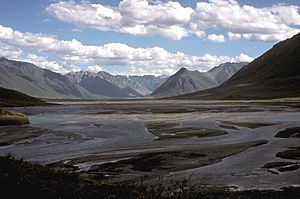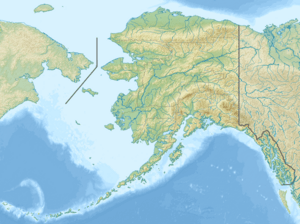Canning River (Alaska) facts for kids
Quick facts for kids Canning River |
|
|---|---|

Confluence with Marsh Fork
|
|
|
Location of the mouth of the Canning River in Alaska
|
|
| Country | United States |
| State | Alaska |
| Borough | North Slope |
| Physical characteristics | |
| Main source | Franklin Mountains Brooks Range 5,157 ft (1,572 m) 69°04′40″N 145°06′07″W / 69.07778°N 145.10194°W |
| River mouth | Camden Bay Beaufort Sea 0 ft (0 m) 70°04′42″N 145°33′56″W / 70.07833°N 145.56556°W |
| Length | 125 mi (201 km) |
The Canning River is a river in Alaska, a large state in the United States. It flows through a northern area called the North Slope. This river is about 125 miles (201 km) long. That's like driving from one city to another!
Contents
Where the Canning River Starts
The Canning River begins high up in the Franklin Mountains. These mountains are part of a bigger mountain range called the Brooks Range. The Brooks Range stretches across northern Alaska. Imagine tall, rocky peaks covered in snow!
Journey to the Sea
From its mountain source, the Canning River flows mostly north. It travels through a very special place. This place is called the Arctic National Wildlife Refuge. It's a huge protected area for animals.
The river finally reaches the Beaufort Sea. This sea is part of the Arctic Ocean. The Canning River meets the sea at a spot called Camden Bay. This is west of a small village named Kaktovik.
Arctic National Wildlife Refuge
The Canning River is important because it flows through the Arctic National Wildlife Refuge. This refuge is often called ANWR. It is one of the largest protected wilderness areas in the world. It covers millions of acres.
Home to Amazing Animals
ANWR is a vital home for many animals. You can find polar bears here. There are also caribou, muskoxen, and arctic foxes. Many kinds of birds also visit the refuge. They come to nest and raise their young.
The river itself provides water for these animals. It also creates important habitats. Fish live in the river's waters. These fish are food for bigger animals.
Why the Refuge is Special
The Arctic National Wildlife Refuge is a wild place. It has mountains, rivers, and coastal plains. It's a place where nature is mostly untouched. Protecting this area helps keep these animals safe. It also preserves a unique part of our planet.


